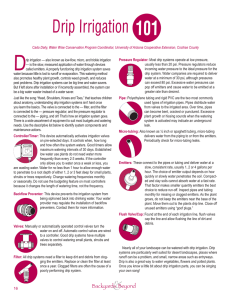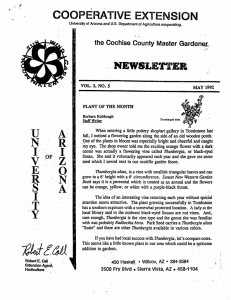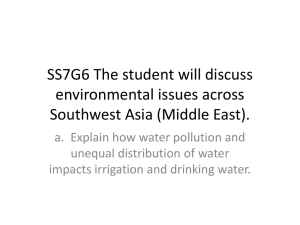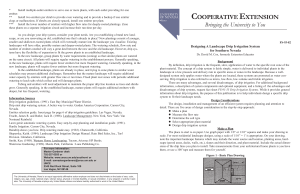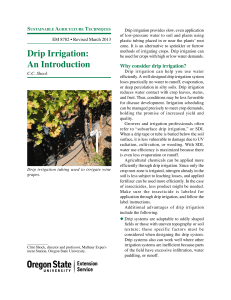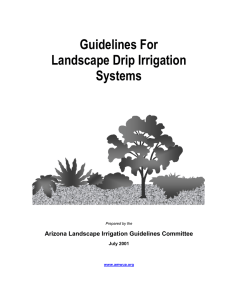D Can I design my own drip irrigation system? YES!
advertisement
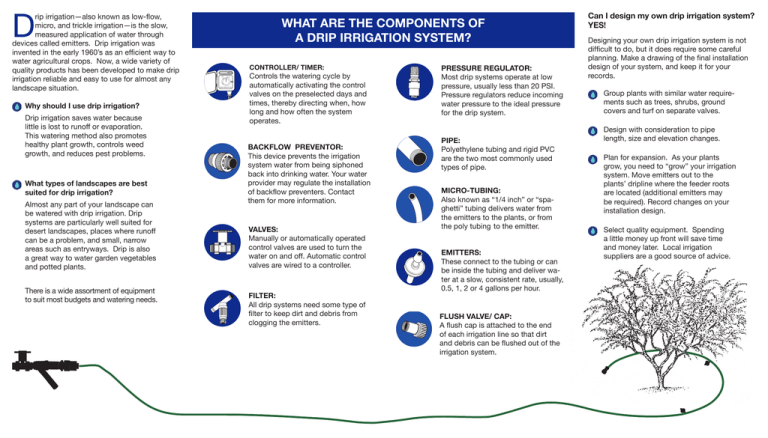
D rip irrigation—also known as low-flow, micro, and trickle irrigation—is the slow, measured application of water through devices called emitters. Drip irrigation was invented in the early 1960’s as an efficient way to water agricultural crops. Now, a wide variety of quality products has been developed to make drip irrigation reliable and easy to use for almost any landscape situation. Why should I use drip irrigation? Drip irrigation saves water because little is lost to runoff or evaporation. This watering method also promotes healthy plant growth, controls weed growth, and reduces pest problems. What types of landscapes are best suited for drip irrigation? Almost any part of your landscape can be watered with drip irrigation. Drip systems are particularly well suited for desert landscapes, places where runoff can be a problem, and small, narrow areas such as entryways. Drip is also a great way to water garden vegetables and potted plants. There is a wide assortment of equipment to suit most budgets and watering needs. WHAT ARE THE COMPONENTS OF A DRIP IRRIGATION SYSTEM? CONTROLLER/ TIMER: Station Watering Time Controls the watering cycle by automatically activating the control valves on the preselected days and times, thereby directing when, how long and how often the system operates. BACKFLOW PREVENTOR: This device prevents the irrigation system water from being siphoned back into drinking water. Your water provider may regulate the installation of backflow preventers. Contact them for more information. VALVES: Manually or automatically operated control valves are used to turn the water on and off. Automatic control valves are wired to a controller. FILTER: All drip systems need some type of filter to keep dirt and debris from clogging the emitters. PRESSURE REGULATOR: Most drip systems operate at low pressure, usually less than 20 PSI. Pressure regulators reduce incoming water pressure to the ideal pressure for the drip system. PIPE: Polyethylene tubing and rigid PVC are the two most commonly used types of pipe. MICRO-TUBING: Also known as “1/4 inch” or “spaghetti” tubing delivers water from the emitters to the plants, or from the poly tubing to the emitter. EMITTERS: These connect to the tubing or can be inside the tubing and deliver water at a slow, consistent rate, usually, 0.5, 1, 2 or 4 gallons per hour. FLUSH VALVE/ CAP: A flush cap is attached to the end of each irrigation line so that dirt and debris can be flushed out of the irrigation system. Can I design my own drip irrigation system? YES! Designing your own drip irrigation system is not difficult to do, but it does require some careful planning. Make a drawing of the final installation design of your system, and keep it for your records. Group plants with similar water requirements such as trees, shrubs, ground covers and turf on separate valves. Design with consideration to pipe length, size and elevation changes. Plan for expansion. As your plants grow, you need to “grow” your irrigation system. Move emitters out to the plants’ dripline where the feeder roots are located (additional emitters may be required). Record changes on your installation design. Select quality equipment. Spending a little money up front will save time and money later. Local irrigation suppliers are a good source of advice. Can sprinklers be converted to a drip system? Yes, there are products that can be installed in place of sprinkler heads. Keep in mind that sprinklers and drip emitters apply water at different rates. They should not be operated from the same valve. You will need to add a pressure reducer and a filter to protect your drip emitters. Remember… Follow manufacturer’s installation recommendations. Change watering schedules according to weather and seasons. Keep filters clean and flush system periodically. Visually inspect emitters and lines monthly to ensure proper water delivery. “Grow” your system as the plants grow. If you have questions or would like workshop information, conservation assistance or other literature, contact your local Cooperative Extension Office. University of Arizona Cooperative Extension cals.arizona.edu/extension/counties Adapted with permission from the Arizona Municipal Water Users Association’s “Drip Irrigation” brochure. Printing Partially Funded by the US Army, Fort Huachuca. Issued in furtherance of Cooperative Extension work, acts of May 8 and June 30, 1914, in cooperation with the U.S. Department of Agriculture, James A. Christenson, Director, Cooperative Extension, College of Agriculture & Life Sciences, The University of Arizona. The University of Arizona is an equal opportunity, affirmative action institution. The University does not discriminate on the basis of race, color, religion, sex, national origin, age, disability, veteran status, or sexual orientation in its programs and activities. Zones Small shrubs and groundcovers Trees and large shrubs Vegetable garden Cooperative Extension Keep good records of your installation design. az 1392 March 2006
